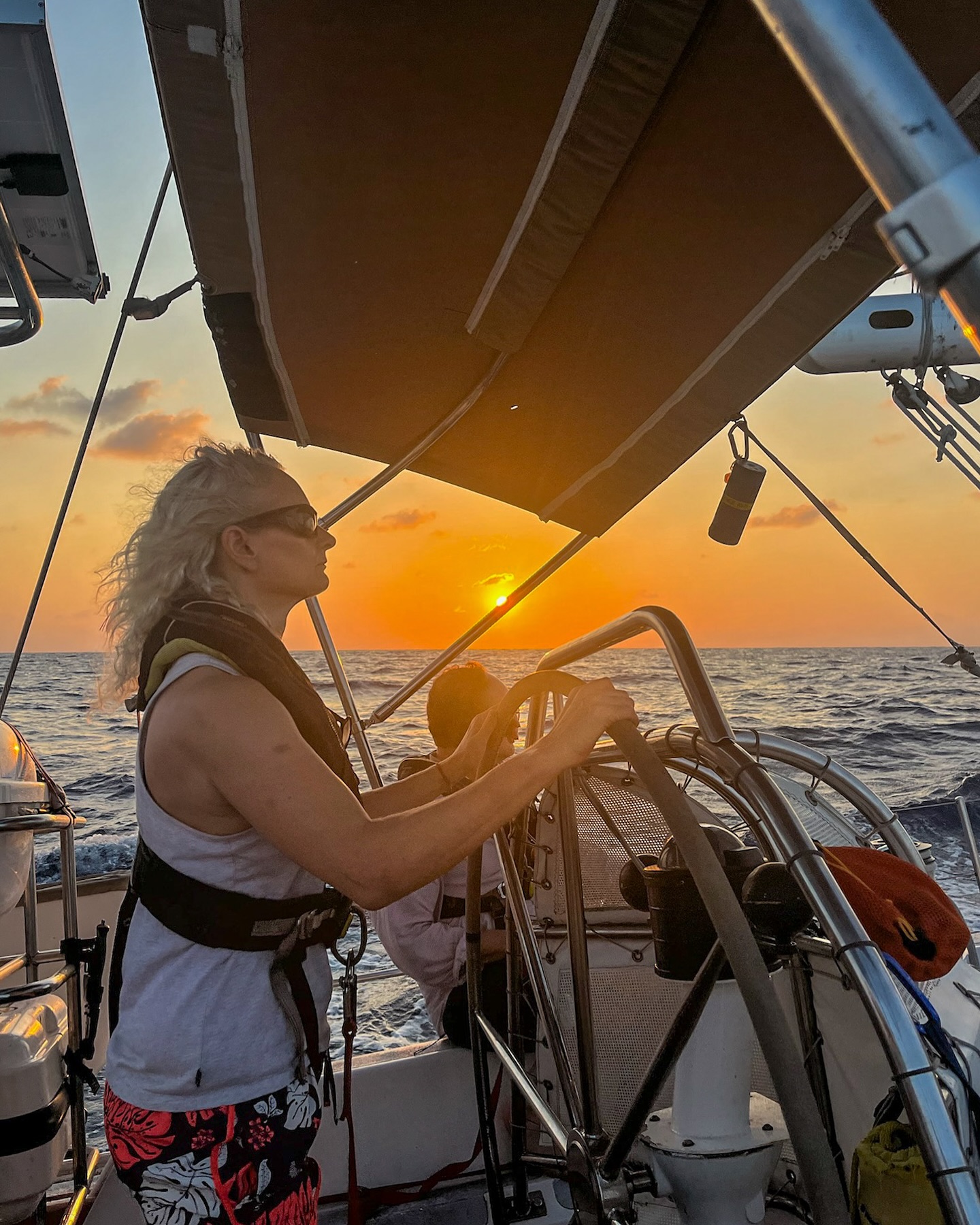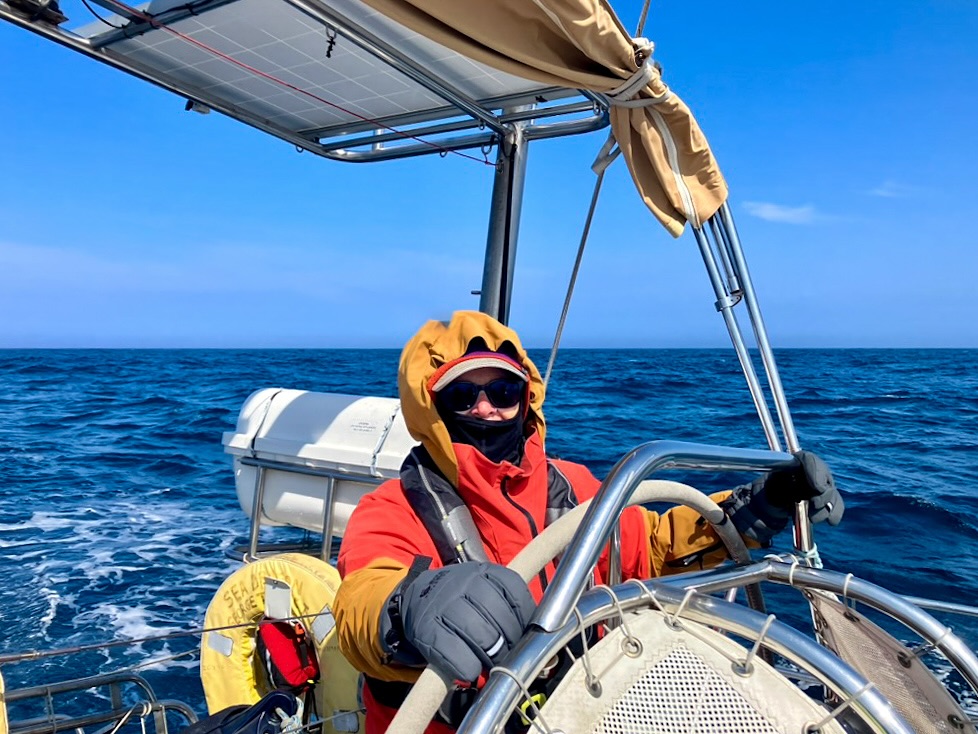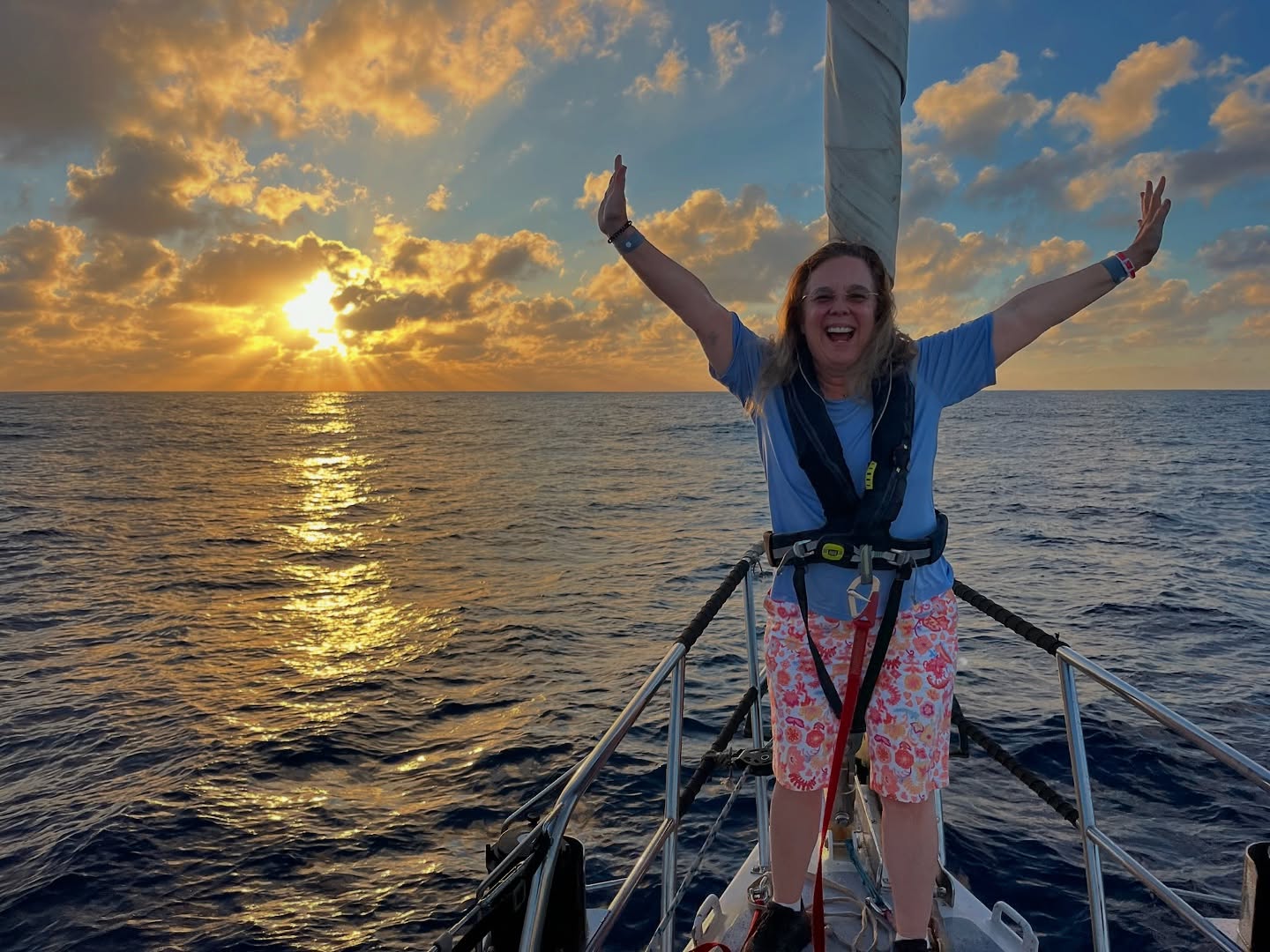All hands on deck
by Charlie Triggs – Deckhand aboard Sea Dragon.
At any one time Pangea Exploration can have between one and three deckhands that help the skipper and first mate to run their ex BT Global Challenge 72ft cutter. Sea Dragon is a MCA category zero coded vessel meaning she will thrive in any ocean on the planet. Sea Dragon was purpose built for sailing the wrong way around the world in the southern ocean with a crew of 18, which means that it takes a good few pairs of hands to get her off the dock and cruising through the worlds oceans. For our sail from Hawaii to Kiribati we have a crew of five. Skipper and first mate; Eric and Shanley, and three deckhands: Jess, Shannon and myself, Charlie. Being a deckhand on Sea Dragon is a unique experience and the three of us are all at different points on our sailing journeys, as well as all coming from and heading to different places. In this blog I’ll talk about about why I wanted, and how I got, to being a deckhand on Sea Dragon, and what this role has been like from a novice’s point of view. Jess will then give you some great advice on being a deckhand from her experiences over the last 10 years.
View from the helm
The bit from Charlie:
I’m 24 and from England. I have an undergraduate degree in Biosciences and am trying to gain more experience in marine biology and conservation. Two of my best mates got me into sailing in my late teens. We sailed along the Norfolk coast and hopped across the English Channel until a year ago, when I completed my RYA Day Skipper certificate and quit my job so I could get as much sailing experience as possible. Around this time I googled ‘research sailing vessels’ to see what would come up and to see if I could combine sailing with marine conservation. One of the boats that came up was Sea Dragon and so I added her to list of boats, that if I could, I would love to sail on.
During that summer I crewed on two delivery passages that came through the Crew Seekers website, these gave me my first tastes of offshore sailing and really enhanced my sailing CV. The second passage finished in Lanzarote and as we approached I heard Sea Dragons name over the VHF. Sure enough a huge cutter with Pangaea Exploration printed on the side was in the marina. I then spent two days walking past before manning up and introducing myself. I jumped over the fence, walked down the pontoon and spoke to Eric who was in a hammock under the bimini, trying to enjoy his newspaper in peace and quiet. He was really friendly and we had a nice chat about our recent passages to Lanzarote. It was then that he told me about deckhand positions on board and that some vacancies for 2018 was be advertised soon. I applied, spoke to Eric and Shanley a few times over Skype, and now here I am writing a blog in the middle the Pacific Ocean. Whoah.
I’ve been on Sea Dragon for six weeks with another six to go before flying back to the UK. It is a great learning environment, especially with Eric and Shanley who are such fountains of wisdom and incredible enthusiastic about sailing and the sea. Everything is done properly, I’ve had more time on the helm than in any of my previous sailing, the auto pilot only being used if absolutely necessary. I’m hoping to complete my Yachtmaster Offshore certificate in the near future, but still feel I need more experience on different boats and in different situations before I’ll feel ready to take it. If you’re lucky enough to be on a boat (especially for long passages) its easy to get the sea miles, half the time you’ll be asleep anyway! It’s the sail changes and the ‘when things go wrong’ experiences that makes you a well rounded sailor. Whenever the wind has allowed we have raised the spinnaker. This takes at least four people and we were having it up and down like a yoyo between Mexico and Hawaii. We also had the poles in and out on each side when sailing wing on wing (Or goose winging as its known in England). I had a little bit of experience with these things, but Eric and Shanley work in a really controlled and methodical manor that make it easy to learn from. My knowledge has been built up steadily as well as my confidence with the sail changes we’ve made.
There’s more to being a deckhand than being on watch and helping sail the boat. Theres also the boat maintenance and media aspects. Boat maintenance is really important in being a well rounded sailor and you can get to know a different side of a boat when its tied to the dock. As mentioned in a few previous blogs we have got really stuck into this side of things especially during our week in Hawaii. Unless you have your own boat or friends with boats it can be hard to get experience in this area. There are so many areas like electronics, carpentry and the main engine which all takes a lot of time to cover. I’ve also found the blogs really fun to write and its nice to have a focus each week and to create something. I rarely jump into the sea without a GoPro and Instagram is a part of everyday life for most people nowadays. But rather than just leaving video and pictures in a file on your laptop it has been great to edit photos which I haven’t done much of before (check out the whale sharks from a few weeks ago).
For me Sea Dragon has really enhanced my sailing experience and built my confidence. At the half way stage I have got a lot more out of this trip than I was hoping for and we still have a month with Woods Hole Oceanographic Institute to go. I’m super excited to see a whole new research operations and logistics side to Sea Dragon over my next 6 weeks!
Shannon and Charlie on watch
The bit from Jess:
I am just rounding into ten years since I started working on boats on and off. Starting as a deckhand with the Canadian Coast Guard, I went on to sailing tall ships, working on commercial fishing vessels, and crewed on various smaller traditional wooden boats – schooners, if I’m being choosy. As a deckhand in these different experiences, I’ve been fortunate to learn from some of the most talented and inspiring mariners. In an attempt to distill from my experience what it means to be a good deckhand, I will suggest the following top three priorities, as well as a few scattered tips for consideration.
Top 3 priorities of being a deckhand: You, Your Crew, Your Vessel
You:
The first part to being a good deckhand is taking care of yourself. This means staying hydrated, and protecting yourself from the sun. Lack of water and too much sun exposure makes for a cranky, tired deckhand. On one of my ships we actually had someone designated as the crew “morale officer” to make sure we were all hydrated and reapplying sunscreen. Ever been really grumpy for what seems like no reason until someone points out that you’re hangry (so hungry you’re angry)? Well being dehydrated and heat exhausted is the same thing. You’re so far gone that you don’t know why it’s SO annoying the way that Susan ties her clove hitches. Drink some water, mate, get outta the sun. YOU tied that clove hitch. As a deckhand, you are an integral part of a team. Take care of yourself and be an active, effective team member.
Your Crew:
See: morale officer above. Take care of each other! See someone looking a bit red? Give em some sunscreen. Someone lost their sea legs? Offer to do their watch chores down below so they can keep their eyes on the horizon and their supper in their tummy. Help out your mates on watch even if they are feeling fine. In some cases they’re the one that has to drive you to shore in the small boat, so the more hands to help, you may just make happy hour after all! Watches on transit can be long, especially if the wind is down. These hours are perfect for getting to know your mates and letting them get to know you. When you’re packing to meet a boat, bring some of your favourite music, books, or podcasts. You will likely be meeting people from different parts of the world and can swap ideas, books, or if you’re like me, spread the joy of Stan Rogers’ baritone ballads across the seas.
Your Vessel:
If you approach each new vessel with an open mind, you will be sure to succeed in sailing that particular vessel (and keep its captain happy). No one likes to hear how you stowed lines on the last boat you were on. Be present. Be adaptable. Take care of your vessel. This means knowing where and when to be gentle and where and when more muscle is required. When you’re finished for the day, take a turn about the deck to see that everything is in its place. Don’t wait to be asked to check dock lines, chafe gear, lashings or the like. Be observant and proactive and you will quickly learn when something needs attention. But don’t attempt to do something you’re unsure about – pick a good time to ask another deckhand or your mate how something is done. Retain this information however you need to – whether that’s writing notes, asking questions, or repeating the task right then and there. Don’t walk away from a lesson with uncertainty. You will be relied upon to do it in the future. The nuances in each of these priorities will come with time, and if you’re ever lucky enough to sail Sea Dragon with Eric and Shanley, they will come in no time. They have an exceptional talent for calm, clear guidance, making your sail not only successful but fun and a great learning experience.
And a few tips from a few mates over the years…
• Mill about smartly – when you have finished a task and everyone else is still working, don’t sit idle or interrupt your mate/skip if they’re in the middle of something. Try to find some productive smaller tasks in the line of sight of your mate/skip. When they see you coiling and recoiling lines, they will know that you are in need of a new task, but will appreciate that you didn’t just take your own little break in the meantime.
• Move with purpose – when you are assigned a task, get ‘er done! You don’t have to rush if its not necessary, but move with intention and keep your purpose top of mind. The sooner you get through the list of jobs for the day, the closer your afternoon swim.
• Don’t cut corners – moving with purpose doesn’t mean rushing. There is a right way to do everything, which you may already know, or you should have been shown by your mate/skip or a fellow deckhand. It’s also really fun to learn all the different types of knots, lashings, whippings, etc. and all the purposes they serve.
• Find dirt and get rid of it – a great idea if you have nothing to do and everyone else is still working on their tasks. Or even if they’re not. Everyone loves a clean boat. But recognise when it’s time to relax – the dirt will be there tomorrow.
• Use the right tool for the job – no, that philips screwdriver is not good enough for those robertson screws. Using the right tool will ensure the longevity of all parts of the boat. Not sure what tool you need? Ask someone, or figure it out, and remember for next time.
• A place for everything and everything in its place – learn where things belong, and put them back where they belong. Keep your personal items in check – water bottles, sunglasses, sunscreen, etc. Where do others keep this stuff? A good rule of thumb is keep your stuff in your bunk, or if you’re on deck, keep them out of the way and remember to grab them at the end of the day.
• Get to know your deck – when you join a boat, spend some time at the beginning or end of the day getting to know which line is which, and the general layout of the boat. Some traditional boats can have over 50 lines on deck, all of which are manila. No fancy pants coloured polyester lines on those boats.
• Safety first, service always – an old ‘Coastie’ adage, but holds true for all boats I think. While being a deckhand is not a dangerous job, if things are done wrong, or you are not prepared, there could be dangerous consequences. Keeping safety your first priority in how you work, you will be sure to succeed in whatever your mission is.
• It might not be noticed if you’re not there, but it will be noticed if you are there – this holds true mostly for bigger boats, when extra hands are needed to help out with something quickly. If you’re not on watch or not called upon, you aren’t required to be on deck – but if you show up on deck anyway ready to help out, your commitment and presence will not go unnoticed.
So all in all being a deckhand on board Sea Dragon is pretty fantastic. If you’re looking for more experience and to hone some of your sailing skills, cover miles, travel, see new places, practise your bowline, take pictures, stare at the sea, clean engines, cook food, be with awesome people, service winches, write blogs, trim sails, clean heads, sail under the stars, and everything else, then you should think about signing up.
Another beautiful Pacific sunset



























